Many travellers in Lombard Italy during the sixth through eighth centuries wrote down inscriptions in syllogae (singular sylloge), providing an important record of what was left of ancient Rome during the Lombard period. Generally written by Anglo-Saxons, the syllogae demonstrate that inscriptions were plentiful along the via Flaminia and in the city of Rome. [1]

In historiography, ancient Rome is Roman civilization from the founding of the Italian city of Rome in the 8th century BC to the collapse of the Western Roman Empire in the 5th century AD, encompassing the Roman Kingdom, Roman Republic and Roman Empire until the fall of the western empire. The civilization began as an Italic settlement in the Italian Peninsula, conventionally founded in 753 BC, that grew into the city of Rome and which subsequently gave its name to the empire over which it ruled and to the widespread civilisation the empire developed. The Roman Empire expanded to become one of the largest empires in the ancient world, though still ruled from the city, with an estimated 50 to 90 million inhabitants and covering 5.0 million square kilometres at its height in AD 117.
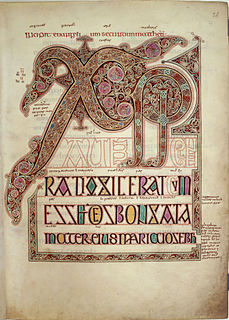
The Anglo-Saxons were a cultural group who inhabited Great Britain from the 5th century, and the direct ancestors of the majority of the modern British people. They comprise people from Germanic tribes who migrated to the island from continental Europe, their descendants, and indigenous British groups who adopted many aspects of Anglo-Saxon culture and language; the cultural foundations laid by the Anglo-Saxons are the foundation of the modern English legal system and of many aspects of English society; the modern English language owes over half its words – including the most common words of everyday speech – to the language of the Anglo-Saxons. Historically, the Anglo-Saxon period denotes the period in Britain between about 450 and 1066, after their initial settlement and up until the Norman conquest. The early Anglo-Saxon period includes the creation of an English nation, with many of the aspects that survive today, including regional government of shires and hundreds. During this period, Christianity was established and there was a flowering of literature and language. Charters and law were also established. The term Anglo-Saxon is popularly used for the language that was spoken and written by the Anglo-Saxons in England and eastern Scotland between at least the mid-5th century and the mid-12th century. In scholarly use, it is more commonly called Old English.
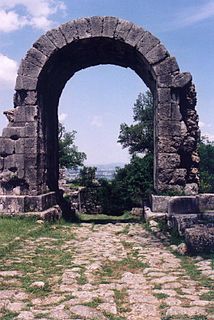
The Via Flaminia was an ancient Roman road leading from Rome over the Apennine Mountains to Ariminum (Rimini) on the coast of the Adriatic Sea, and due to the ruggedness of the mountains was the major option the Romans had for travel between Etruria, Latium, Campania, and the Po Valley. Today the same route, still called by the same name for much of its distance, is paralleled or overlaid by Strada Statale (SS) 3, also called Strada Regionale (SR) 3 in Lazio and Umbria, and Strada Provinciale (SP) 3 in Marche. It leaves Rome, goes up the Val Tevere and into the mountains at Castello delle Formiche, ascends to Gualdo Tadino, continuing over the divide at Scheggia Pass, 575 m (1,886 ft) to Cagli. From there it descends the eastern slope waterways between the Tuscan-Emilian Apennines and the Umbrian Apennines to Fano on the coast and goes north, parallel to Highway A1 to Rimini.
The reasons for recording inscriptions varied. Some are interested solely in inscriptions on churches and Christian monuments. These, like Sylloge einsiedlensis from the time of Charlemagne and Pope Hadrian I, often include itineraries of "the places of the saints" (loca sanctorum), for the benefit of fellow pilgrims, and reports of the liturgical practices of the Patria sancti Petri . [1] Others, like the Sylloge laureshamensis, contain classical and pagan inscriptions with references to emperors, important personages, titles and offices. The author of the Laureshamensis traversed the peninsula between Rome and Ivrea, passing through Milan, Pavia, Piacenza, Ravenna, Spoleto and Vercelli. He had a special interest in metrical inscriptions and his Piacentine collection he divided under the headings RITHM and METR, indicating rhythmic and hexametric metre, respectively. [1]
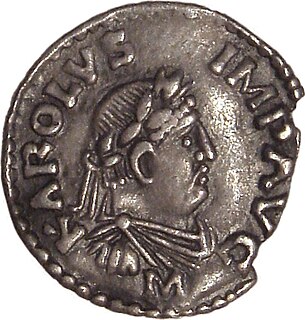
Charlemagne or Charles the Great, numbered Charles I, was King of the Franks from 768, King of the Lombards from 774, and Holy Roman Emperor from 800. He united much of western and central Europe during the Early Middle Ages. He was the first recognised emperor to rule from western Europe since the fall of the Western Roman Empire three centuries earlier. The expanded Frankish state that Charlemagne founded is called the Carolingian Empire. He was later canonized by Antipope Paschal III.

Ivrea is a town and comune of the Metropolitan City of Turin in the Piedmont region of northwestern Italy. Situated on the road leading to the Aosta Valley, it straddles the Dora Baltea and is regarded as the centre of the Canavese area. Ivrea lies in a basin that in prehistoric times formed a large lake. Today five smaller lakes — Sirio, San Michele, Pistono, Nero and Campagna — are found in the area around the town.

Milan is a city in northern Italy, capital of Lombardy, and the second-most populous city in Italy after Rome, with the city proper having a population of 1,372,810 while its metropolitan city has a population of 3,245,308. Its continuously built-up urban area has a population estimated to be about 5,270,000 over 1,891 square kilometres. The wider Milan metropolitan area, known as Greater Milan, is a polycentric metropolitan region that extends over central Lombardy and eastern Piedmont and which counts an estimated total population of 7.5 million, making it by far the largest metropolitan area in Italy and the 54th largest in the world. Milan served as capital of the Western Roman Empire from 286 to 402 and the Duchy of Milan during the medieval period and early modern age.
The Sylloge centulensis, from an eighth- or ninth-century manuscript of the monastery of Corvey, compiled on a trip from Rome to Spoleto to Ravenna, records "what we might term Petrean poetry", a style lying between classical and medieval forms. [2] The seventh-century Sylloge turonensis concentrates on the monuments of Rome. Later examples include the Sylloge parisina, the Sylloge virdunensis and the Sylloge wirceburgensis. [1]
The surviving syllogae were first edited and studied by the archaeologist Giovanni Battista de Rossi, who published them in the first part of the second volume of his monumental Inscriptiones christianae urbis Romae septimo saeculo antiquiores (Rome: 1857, 1861–88). [1]

Giovanni Battista (Carlo) de Rossi was an Italian archaeologist, famous even outside his field for rediscovering early Christian catacombs.
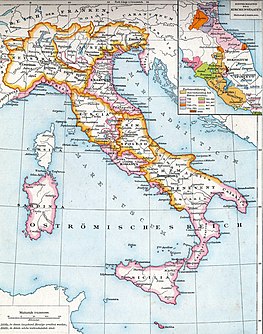
The Lombards or Longobards were a Germanic people who ruled most of the Italian Peninsula from 568 to 774.

Ravenna is the capital city of the Province of Ravenna, in the Emilia-Romagna region of Northern Italy. It was the capital city of the Western Roman Empire from 402 until that empire collapsed in 476. It then served as the capital of the Ostrogothic Kingdom until it was re-conquered in 540 by the Byzantine Empire. Afterwards, the city formed the centre of the Byzantine Exarchate of Ravenna until the invasion of the Lombards in 751, after which it became the seat of the Kingdom of the Lombards.

Pope Paul I was Pope from 29 May 757 to his death in 767. He first served as a Roman deacon and was frequently employed by his brother, Pope Stephen II, in negotiations with the Lombard kings.

Umbria is a region of central Italy. It includes Lake Trasimeno and Marmore Falls, and is crossed by the River Tiber. The regional capital is Perugia. Umbria is known for its landscapes, traditions, history, culinary delights, artistic legacy, and influence on culture.

Spoleto is an ancient city in the Italian province of Perugia in east-central Umbria on a foothill of the Apennines. It is 20 km (12 mi) S. of Trevi, 29 km (18 mi) N. of Terni, 63 km (39 mi) SE of Perugia; 212 km (132 mi) SE of Florence; and 126 km (78 mi) N of Rome.

Romagna is an Italian historical region that approximately corresponds to the south-eastern portion of present-day Emilia-Romagna, North Italy. Traditionally, it is limited by the Apennines to the south-west, the Adriatic to the east, and the rivers Reno and Sillaro to the north and west. The region's major cities include Cesena, Faenza, Forlì, Imola, Ravenna, Rimini and City of San Marino. The region has been recently formally expanded with the transfer of seven comuni from the Marche region, which are a small number of comuni where Romagnolo dialect is spoken.
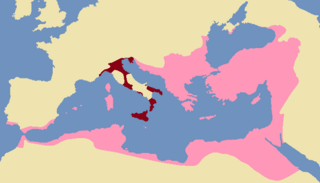
The Exarchate of Ravenna or of Italy was a lordship of the Byzantine Empire in Italy, from 584 to 751, when the last exarch was put to death by the Lombards. It was one of two exarchates established following the western reconquests under Emperor Justinian to more effectively administrate the territories, along with the Exarchate of Africa.
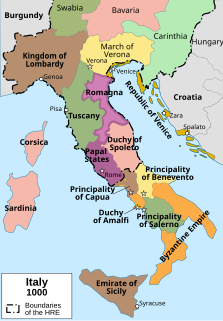
The Duchy of Spoleto was a Lombard territory founded about 570 in central Italy by the Lombard dux Faroald. Its capital was the city of Spoleto.

The Duchy of Benevento was the southernmost Lombard duchy in the Italian peninsula, centered on Benevento, a city in Southern Italy. Being cut off from the rest of the Lombard possessions by the papal Duchy of Rome, Benevento was practically independent from the start. Only during the reigns of Grimoald, King of the Lombards and the kings from Liutprand on was the duchy closely tied to the kingdom. After the fall of the kingdom, however, alone of Lombard territories it remained as a rump state, and maintained its de facto independence for nearly three hundred years, though it was divided after 849.

Liutprand was the King of the Lombards from 712 to 744 and is chiefly remembered for his Donation of Sutri, in 728, and his long reign, which brought him into a series of conflicts, mostly successful, with most of Italy. He is often regarded as the most successful Lombard monarch, notable for the Donation of Sutri, which was the first accolade of sovereign territory to the Papacy.

The Via Cassia was an important Roman road striking out of the Via Flaminia near the Milvian Bridge in the immediate vicinity of Rome and, passing not far from Veii, traversed Etruria. The Via Cassia passed through Baccanae, Sutrium, Volsinii, Clusium, Arretium, Florentia, Pistoria, and Luca, joining the Via Aurelia at Luna.
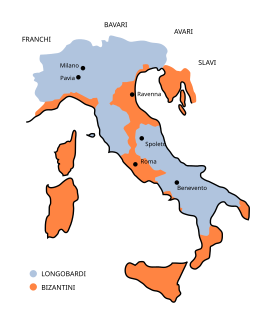
Langobardia Minor was the name that, in early Middle Ages, was given to the Lombard dominion in central-southern Italy, corresponding to the duchies of Spoleto and Benevento. After the conquest of the Lombard kingdom by Charlemagne in 774 it remained under Lombard control.
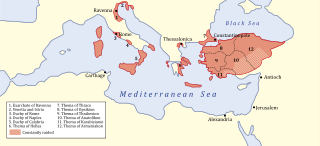
The Duchy of Rome was a state within the Byzantine Exarchate of Ravenna. Like other Byzantine states in Italy, it was ruled by an imperial functionary with the title dux. The duchy often came into conflict with the Papacy over supremacy within Rome. The duchy was founded by the conquest of Emperor Justinian I in 533 AD. After the founding of the Papal States in 751, the title of Duke of Rome fell into disuse.
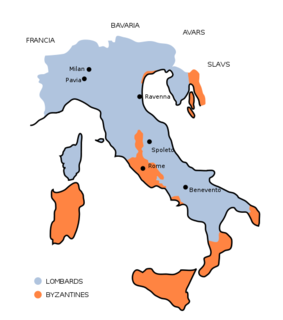
The Kingdom of the Lombards also known as the Lombard Kingdom; later the Kingdom of (all) Italy, was an early medieval state established by the Lombards, a Germanic people, on the Italian Peninsula in the latter part of the 6th century. The king was traditionally elected by the highest-ranking aristocrats, the dukes, as several attempts to establish a hereditary dynasty failed. The kingdom was subdivided into a varying number of duchies, ruled by semi-autonomous dukes, which were in turn subdivided into gastaldates at the municipal level. The capital of the kingdom and the center of its political life was Pavia in the modern northern Italian region of Lombardy.
Faroald II was the duke of Spoleto from 703, when he succeeded his own father Thrasimund I.
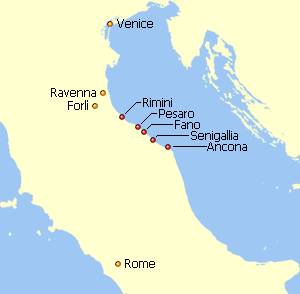
In the Byzantine Empire, the Duchy of the Pentapolis was a duchy, a territory ruled by a duke (dux) appointed by and under the authority of the Praetorian Prefect of Italy (554–584) and then the Exarch of Ravenna (584–751). The Pentapolis consisted of the cities of Ancona, Fano, Pesaro, Rimini and Sinigaglia. It lay along the Adriatic coast between the rivers Marecchia and Misco immediately south of the core territory of the exarchate ruled directly by the exarch, east of the Duchy of Perugia, another Byzantine territory, and north of the Duchy of Spoleto, which was part of the Lombard Kingdom of Italy. The duchy probably extended inland as far as the Apennine Mountains, perhaps beyond, and its southernmost town was Humana (Numera) on the northern bank of the Misco. The capital of the Pentapolis was Rimini and the duke was both the civil and military authority in the duchy.
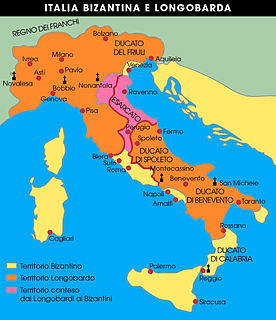
The Duchy of Perugia was a duchy in the Italian part of the Byzantine Empire. Its civil and military administration was overseen by a duke (dux) appointed by and under the authority originally of the Praetorian Prefect of Italy (554–584) and later of the Exarch of Ravenna (584–751). Its chief city and namesake was Perugia (Perusia), located at its centre. It was a band of territory connecting the Duchy of the Pentapolis to its northeast with the Duchy of Rome to its southwest, and separating the duchies of Tuscia and Spoleto, both parts of the Lombard Kingdom of Italy. It was of great strategic significance to the Byzantines since it provided communication between Rome, the city of the Popes, and Ravenna, the capital of the Exarchate. Since it cut off the Duke of Spoleto from his nominal overlord, the king ruling from Pavia, it also disturbed the Lombard kingdom, which was a constant thorn in the Byzantines' side. This strategic importance meant that many Lombard and Byzantine armies passed through it.

Classe was a commercial port located 4 km (2.5 mi) east south east from Ravenna, Italy. It was near the head of the Adriatic coast. For almost five hundred years it was an important strategic military port. When it was not being used as a military port, it was an important commercial port for the imperial capital of Ravenna in the Roman Empire. Classe comes from the Latin word classis, meaning fleet.
Syllogae minores is a term used in literature to describe small collections of Greek epigrams, which are part of the so-called Greek Anthology, the collection of Greek epigrams. The term "Syllogae" comes from the Greek word "Συλλογαί" (collections), while the term "minores" (minor) is used to distinguish them from the large and important collections of Palatine Anthology and the Anthology of Planudes. Some of these collections are important because of the epigrams which contain some not found in any of the other collections, while others are highly dependent on known sources, mainly of the Anthology of Planudes.























